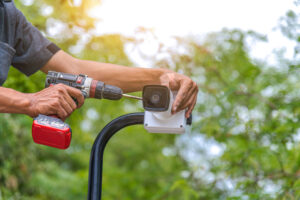Making your alarm system energy-efficient not only lowers your utility bills but also contributes to creating a smarter, more sustainable home.
By integrating energy-saving features into your security setup, you can significantly reduce energy consumption while enhancing security.
Below, we will walk you through practical strategies and tips to optimize your alarm system, making your home more efficient without compromising safety.
Why an Energy-Efficient Alarm System is Important
An energy-efficient alarm system can drastically reduce your home’s energy consumption, helping you save money over time. With the integration of smart technology, you can automate various functions like lighting and heating, allowing your system to work smarter, not harder. Not only does this improve the overall energy efficiency of your home, but it also supports sustainability goals by reducing your carbon footprint.
Key Benefits of Energy-Efficient Alarm Systems:
- Lower Utility Bills: By reducing unnecessary energy consumption, you’ll notice a decrease in your monthly energy bills.
- Enhanced Security: Automated lighting, motion sensors, and other features increase your home’s security while saving energy.
- Eco-Friendly: Reducing energy usage helps you contribute to environmental conservation by lowering your carbon footprint.
1. Integrating Smart Home Features for Better Efficiency
Integrating your alarm system with other smart home features is one of the most effective ways to improve energy efficiency. Smart homes are designed to adjust to your lifestyle, optimizing energy use while keeping your home secure.
How Smart Home Devices Help Save Energy:
- Smart Lighting: Automating your lighting with smart bulbs and motion sensors ensures lights are only on when needed. This eliminates energy waste from leaving lights on in empty rooms.
- Smart Thermostats: A smart thermostat learns your schedule and adjusts your home’s temperature based on when you are present or away. This minimizes heating or cooling when it’s unnecessary.
- Voice-Controlled Smart Devices: Integration with voice assistants like Amazon Alexa or Google Assistant allows you to control your alarm system, lights, and thermostat hands-free, making it easier to adjust settings as needed.
By connecting your alarm system to your smart home network, you gain the ability to automate lighting, heating, and cooling, which can significantly reduce energy consumption.
2. Choosing Energy-Saving Devices
When designing an energy-efficient alarm system, selecting the right devices is crucial. Look for components that offer smart features and consume minimal power.
Features to Look for in Energy-Saving Devices:
- Low Power Consumption: Choose devices like smart sensors, cameras, and alarms with energy-efficient components that consume less electricity.
- Solar-Powered Devices: For outdoor alarm systems, solar-powered cameras or sensors reduce reliance on mains electricity and can be an excellent way to save energy.
- Motion Sensors: Motion detectors that activate only when necessary can save significant energy by preventing false alarms and unnecessary power consumption. For example, motion-activated lights only turn on when someone enters a room.
Device Examples:
- Smart Motion Sensors: These can be integrated with lighting and security cameras to only activate when they detect motion, reducing energy waste.
- Battery-Powered Devices: Many modern alarm systems now offer battery-operated sensors and detectors, which use less power than wired systems and can be easier to manage.
Opting for energy-efficient devices not only saves energy but also reduces long-term costs. While the initial investment might be higher, the savings over time can make up for the upfront costs.
3. Automating Lighting and Heating
Automating your lighting and heating systems is a key step toward making your home more energy-efficient. Smart devices can learn your habits and adjust settings automatically to avoid wasting energy.
Automating Lighting
With a smart lighting system, you can program lights to turn off when they’re not in use or adjust their brightness based on the time of day.
Key Lighting Automation Features:
- Task Tuning: Adjust the brightness of lights to the needs of the space, avoiding over-lit areas.
- Daylight Harvesting: Smart lights that adjust their intensity based on the natural light levels in the room.
- Occupancy Sensors: These sensors turn lights off when no one is in the room, ensuring that lights are only on when needed.
By implementing these features, you can significantly reduce energy consumption from lighting without sacrificing convenience or security.
Optimizing Heating Systems
Heating and cooling systems are the largest consumers of energy in many homes. Fortunately, optimizing these systems is straightforward.
Key Strategies to Optimize Heating:
- Smart Thermostats: Install a programmable thermostat that adjusts the temperature when you’re not at home or during the night, helping to save energy.
- Proper Insulation: Ensure that your home is properly insulated to prevent heat loss in the winter and keep cool air inside during summer.
- Maintenance: Regularly service your heating system to maintain efficiency. Clean filters, and check for any leaks or malfunctions that may be increasing energy consumption.
Implementing these steps will ensure that your heating system only uses energy when necessary, contributing to overall energy efficiency.
4. Creating Energy-Saving Schedules
One of the easiest ways to reduce energy consumption in your alarm system and other smart devices is through scheduling. By setting schedules that align with your routine, you can automate energy-saving functions.
How Scheduling Helps:
- Time-Based Settings: Set your alarm system, lights, and thermostat to operate at certain times of the day. For example, you can schedule lights to turn off when you leave for work and turn on automatically when you return home.
- Geo-Services: Use location-based rules with smart thermostats that adjust the temperature based on whether you’re at home or away.
- Automated Lighting: Lights can be scheduled to only turn on when needed, such as when you’re near a specific room, reducing unnecessary energy use.
Scheduling not only saves energy but also ensures your home remains secure without requiring constant manual adjustments.
5. Optimizing Energy Use with Motion Sensors
Motion sensors are a key component in making your alarm system more energy-efficient. These sensors can trigger alarms, lights, or cameras only when necessary, saving energy and reducing wear on your devices.
How Motion Sensors Contribute to Energy Efficiency:
- Motion-Activated Lighting: Lights automatically turn off when motion is no longer detected, preventing unnecessary power consumption.
- Targeted Security Recording: Security cameras with motion detection only record when they detect movement, saving energy compared to continuous recording.
- Reduced False Alarms: Advanced motion sensors reduce false alarms by distinguishing between human movement and other factors, further conserving energy.
By using motion sensors effectively, you reduce unnecessary power use while ensuring that your home remains protected.
6. Setting Up Remote Controls for Convenient Management
Remote control capabilities make it easier to manage your alarm system and associated smart devices, enhancing both security and energy efficiency.
Key Features to Look for in Remote Control Systems:
- System Modes: Ensure that the remote control allows you to easily switch between modes (e.g., home, away, night) to adjust your system for maximum energy efficiency.
- Alert Customization: Customize alerts to notify you only when necessary, reducing unnecessary notifications that could lead to system inefficiency.
- Integration with Other Smart Devices: Ensure that your remote control integrates well with other devices in your home, such as smart thermostats, lighting, and cameras, allowing for unified control and better energy management.
By connecting your alarm system to a remote control app, you can optimize your energy use from anywhere, even while away from home.
Conclusion
Making your alarm system energy-efficient is a practical and effective way to reduce your energy bills and enhance your home security. By integrating smart home features, choosing energy-saving devices, automating lighting and heating, and leveraging motion sensors, you can significantly cut down on unnecessary energy consumption. Additionally, creating energy-saving schedules and using remote controls further optimize energy use in your home.
By taking the time to implement these energy-efficient strategies, you’ll not only save money but also contribute to a more sustainable and eco-friendly home.



